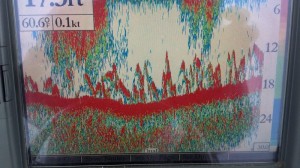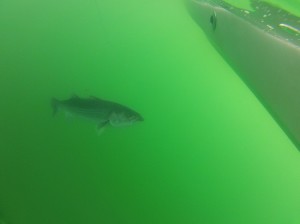With the amount of lures and tackle on the market today, it can sometimes get a little overwhelming trying to decide what to use in certain situations. Should I be trolling an umbrella rig, slinging a Sebile or drifting live bait?
Well at this time of the year my strategy is pretty simple. 90% of the time when heading out in my boat I am using either live eels or the tube and worm. These two techniques work well on big summer time striped bass and are easy for charter folks to learn.
In particular the tube and worm has a special place in my night fishing approach. Trolling the tube is a safe way to fish at night because you are moving forward at less than 3mph - which is pretty important especially on those dark nights with no moon. Tubes also work very well on lethargic mid summer stripers.
Having an understanding of how bass behave after dark and how to find big bass at night is pretty important to night time tube and worm trolling success.
Of course bass behave differently in different areas along the striper coast, and not all night fishing scenarios are alike. However the below tips have helped me dramatically in my night time tube and worm trolling adventures, and I hope they help you as well!
I also put together a whiteboard video for blog members interested in learning more about how bass behave at night and how to find bass at night. Just click here to check it out. Thanks!
Night Time Bass Behavior
Having an idea as to how striped bass in your area behave throughout the course of a night can dramatically increase your nocturnal tube and worming success.
Since I was a kid I have noticed that tubes trolled closer to the surface out produce tubes trolled deep-at least when night time trolling. The day time crowd may do a killing in a specific spot trolling 5-7 colors. However once the sun sets, bass typically abandon their deep haunts and venture closer to the surface. Over the past few seasons we have caught over 90% of striped bass at night trolling just 3-4 colors-even in water as deep as 80 feet.
I have also noticed that the bass population in a certain area tends to move in the same general direction throughout the course of the night. In open water areas devoid of structure and current, stripers tend to remain in motion and travel together in a certain direction. Having an idea as to the direction the bass on your sonar are headed can help you develop a repeatable trolling pattern that will put your tubes in front of the bass for as long as possible.

Unfortunately striped bass are not always aggressive at night. This rings especially true during the dog days of summer. Encountering large schools of striped bass that have “lock jaw” and are unwilling to bite even live bait is not entirely out of the question. The tube and worm is a particularly effective choice during these lock jaw situations, because the tube will often provoke a bite from even the most lethargic of striped bass.
The most interesting of night time striped bass behaviors is what’s known to biologists as “shoaling.” Many fish species, including striped bass, only exhibit shoaling behavior during the night. In these situations individual fish spread out in random formations, spaced rather evenly from one another. Striped bass typically shoal close to the surface, no deeper than 15 feet, throughout the night.
Shoals of striped bass can number well into the thousands and extend for more than a mile in length. On some nights the entire shoal of striped bass is in the feeding mood-on others only the most meticulously presented tube and worm will generate a strike.
Click here for more informationabout the difference between shoaling striped bass and schooling striped bass.
Finding Bass at Night
Finding a good place to drag tubes is hands down the most challenging and important aspect of nocturnal tube and worm trolling. The best gear, most effective tubes and juiciest worms won't catch a thing if there are no fish in the area you are fishing. Therefore it's important to develop a strategy for finding productive waters.
There's no doubt that moon phases, tides, weather patterns etc. all have some sort of impact on where striped bass go. Unfortunately, despite my best efforts, I have not been able to link all the variables and data together in any way that helps me to predict exactly where the bass will be on a given night. Often times the exact same tide and weather conditions will repeat themselves, however the bass will be in completely different areas exhibiting completely different behaviors. Trying to predict exactly where bass will be holding and how bass will be acting has been a pretty fruitless endeavor for me.
Instead of studying a decade’s worth of fishing data, I opt to keep things as simple as possible. When searching for bass at night, the only factors I take into consideration are the time of the season, the time of the night and where I found stripers last time I went fishing.
When searching for bass at night it can help to think in terms of finding the “biomass” as opposed to finding a single fish or two. At night we are looking for areas that may hold hundreds and thousands of fish-not just a few bass here and there. It’s often possible to cover miles of open water before stumbling upon an area chock full of life. Over the past few years it’s not been unusual for us to cover over 50 miles in one night searching for and attempting to remain with a biomass of striped bass.

Viewed from this perspective it is important to be able to operate your sonar when traveling at a speed other than the typical 2mph or so tube and worm trolling pace. Covering 50 or more miles while trolling will literally take all day, while covering 50 or more miles when traveling at a reasonable clip of speed is very feasible. On most color sonar units, solitary bass will register on the screen as small orange blotches. Remember that finding just one solitary bass is a big accomplishment. That one bass could be one of hundreds or thousands of fish shoaling or schooling in the area.
If you find the biomass, keep in mind that odds are that the bass will be moving in the same general direction. The pace at which the fish are moving will vary considerably, however it is rare that bass will remain holding in a specific spot-unless there is significant structure or current keeping them put. If you stop marking bass while trolling or searching, consider the chance that you have come to the end of the productive stretch of water, and that the bass may not be moving in the direction you are traveling or trolling.
As an example we have had nights in which we spent the majority of our time trolling in the same half mile stretch of water. At the end of the stretch of water we would simply cruise back to the beginning of the stretch and troll right back along our GPS track. On other nights we have trolled in a given direction for hours and miles on end, never turning around or altering our course. In these instances we were fortunate to troll along with the biomass of stripers as they swam in the same direction as our troll.
Of course we have had nights in which we marked enormous amounts of bass, caught a few fish and then to our dismay, completely lost track of the bass. In these moments we were unable to distinguish which direction the biomass was moving, and thus lost out on a good opportunity to catch a lot of fish.
Click here for a video about how to zone in on schools of striped bass under the cover of darkness.
Tight lines and good luck tubing!
Ryan


Great article! Very invaluable information on striper fishing at night.
I’m glad you found it valuable Robert. LMK if you have any questions, and good luck!